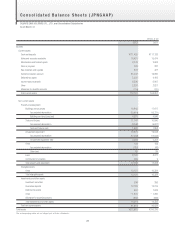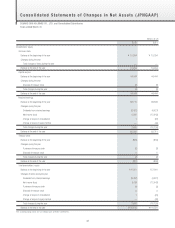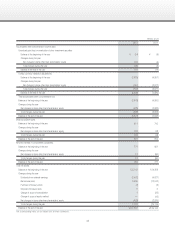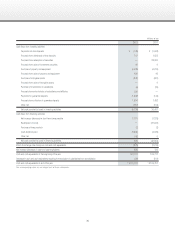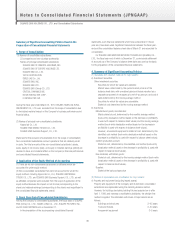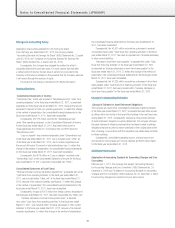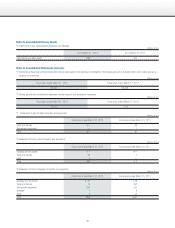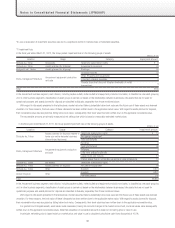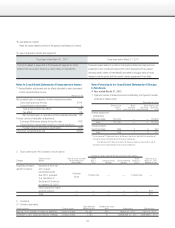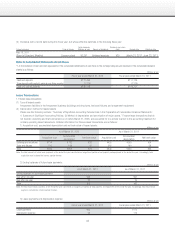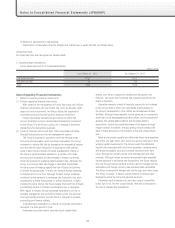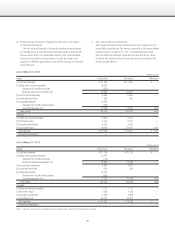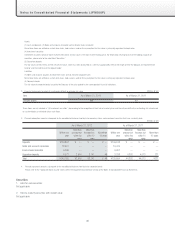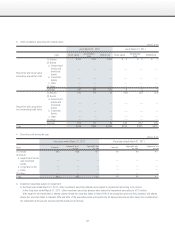Square Enix 2012 Annual Report Download - page 40
Download and view the complete annual report
Please find page 40 of the 2012 Square Enix annual report below. You can navigate through the pages in the report by either clicking on the pages listed below, or by using the keyword search tool below to find specific information within the annual report.
38
Notes to Consolidated Financial Statements (JPNGAAP)
Changes in Accounting Policy
(Application of accounting standard for net income per share)
From the fiscal year ended March 31, 2012, the Company applies
“Accounting Standard for Earnings Per Share” (ASBJ Statement No. 2, issued
June 30, 2010) and “Guidance on Accounting Standard for Earnings Per
Share” (ASBJ Guidance No. 4, issued June 30, 2010).
Consequently, the Company has changed the method by which it
calculates diluted net income per share. For stock options that vest after
a certain period of service, the fair value of service to be provided to the
Company in the future is included in the proceeds that the Company assumes
it will receive through the exercise of rights.
The impact of this change is described in Per Share Information.
Reclassifications
(Consolidated Statements of Income)
“Commission fee,” which was included in “Miscellaneous loss” under “Non-
operating expenses” in the fiscal year ended March 31, 2011, is presented
separately as of the fiscal year ended March 31, 2012, because the amount
exceeded 10 percent of total non-operating expenses. To reflect this change
in the method of presentation, the consolidated financial statements for the
fiscal year ended March 31, 2011, have been reclassified.
Consequently, the ¥73 million recorded for “Miscellaneous loss”
under “Non-operating expenses” on the Consolidated Statement of Income
for the fiscal year ended March 31, 2011, has been broken down to
reveal specifically ¥44 million for “Commission fee” and ¥28 million for
“Miscellaneous loss.”
“Loss on disaster” was presented separately under “Extraordinary loss”
in the fiscal year ended March 31, 2011, but is included under “Other” as
of the fiscal year ended March 31, 2012, due to reduced significance as
the amount fell below 10 percent of total extraordinary loss. To reflect this
change in the method of presentation, the consolidated financial statements
for the fiscal year ended March 31, 2011, have been reclassified.
Consequently, the ¥570 million in “Loss on disaster” recorded under
“Extraordinary loss” on the Consolidated Statement of Income for the fiscal
year ended March 31, 2011, has been incorporated into “Other.”
(Consolidated Statements of Cash Flows)
“Reversal of foreign currency translation adjustments,” a separate item under
“Cash flows from operating activities” in the fiscal year ended March 31,
2011, was included within “Other, net” in the fiscal year ended March 31,
2012, because of its reduced monetary significance. To reflect this change
in the method of presentation, the consolidated financial statements for the
fiscal year ended March 31, 2011, have been reclassified.
Consequently, the gain of ¥317 million from foreign currency translation in
the fiscal year ended March 31, 2011, has been incorporated into “Other, net.”
“Increase (decrease) in accrued consumption taxes,” a separate
item under “Cash flows from operating activities” in the fiscal year ended
March 31, 2011, was included within “Increase (decrease) in other current
liabilities” in the fiscal year ended March 31, 2012, because of its reduced
monetary significance. To reflect this change in the method of presentation,
the consolidated financial statements for the fiscal year ended March 31,
2011, have been reclassified.
Consequently, the ¥2,421 million recorded as a decrease in accrued
consumption taxes under “Cash flows from operating activities” in the fiscal
year ended March 31, 2011, has been incorporated into “Increase (decrease)
in other current liabilities.”
“Decrease in short-term loans payable,” a separate item under “Cash
flows from financing activities” in the fiscal year ended March 31, 2011,
is presented as “Increase (decrease) in short-term loans payable” in the
fiscal year ended March 31, 2012. To reflect this change in the method of
presentation, the consolidated financial statements for the fiscal year ended
March 31, 2011, have been reclassified.
Consequently, the ¥1,325 million recorded as a decrease in short-term
loans payable under “Cash flows from financing activities” in the fiscal year
ended March 31, 2011, has been included within “Increase (decrease) in
short-term loans payable” for the fiscal year ended March 31, 2012.
Changes in Accounting Estimates
(Change in Estimate for Asset Retirement Obligations)
The Company and some of its consolidated subsidiaries made the decision
in the fiscal year ended March 31, 2012, to relocate the head office as well
as offices within the vicinity of the head office building in the next fiscal year,
ending March 31, 2013. Consequently, because a more precise estimate
of asset retirement obligations could be determined, the Company changed
the asset retirement obligations estimate that had been booked to address
obligations that are incurred to restore premises to their original state at the
time of leaving, in accordance with the respective real estate lease contracts
for these buildings.
Consequently, consolidated operating income, ordinary income and
income before income taxes and minority interests are ¥508 million higher
for the fiscal year ended March 31, 2012.
Additional Information
(Application of Accounting Standard for Accounting Changes and Error
Corrections)
Effective April 1, 2011, the Company has applied “Accounting Standard
for Accounting Changes and Error Corrections” (ASBJ Statement No. 24,
December 4, 2009) and “Guidance on Accounting Standard for Accounting
Changes and Error Corrections” (ASBJ Guidance No. 24, December 4, 2009)
for accounting changes and corrections of prior period errors.


